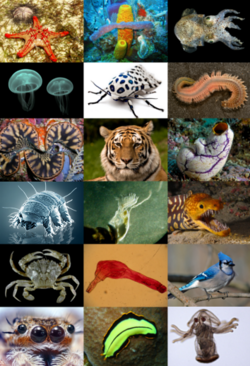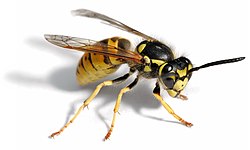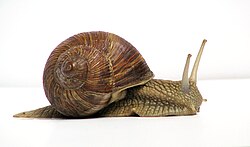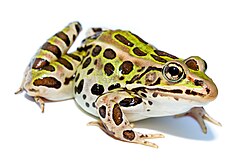Animal
Animals (or Metazoa) are living creatures with many cells that make up the kingdom Animalia.
| Animalia | |||
|---|---|---|---|
| Scientific classification | |||
| Domain: | Eukaryota | ||
| (unranked): | Unikonta | ||
| (unranked): | Obazoa | ||
| (unranked): | Opisthokonta | ||
| (unranked): | Holozoa | ||
| (unranked): | Filozoa | ||
| Kingdom: | Animalia Linnaeus, 1758 | ||
| Phyla | |||
| |||
| Synonyms | |||
| |||
Animals get their energy from other living things. Usually, they eat them or are parasites. Animals, plants, fungi, and some other living things have complex cells, so they are grouped together as eukaryotes.
The study of animals is called zoology.[1][2][3] The study of ancient life is called palaeontology.
Most animals are mobile, meaning they can move around. Animals take in oxygen, and give out carbon dioxide.[4] This cellular respiration is part of their metabolism (chemical working). In both these ways they are different from plants. Also, the cells of animals have different cell membranes to other eukaryotes like plants and fungi.
Plants are also multicellular eukaryotic organisms, but live by using light, water and basic elements to make their tissues.
Grouping animals
There are many different types of animals. The common animals most people know are only about 3% of the animal kingdom. When biologists look at animals, they find things that certain animals have in common. They use this to group the animals in a biological classification. Several million species may exist, but biologists have only identified about one million.
Animals can mainly be divided into two main groups: the invertebrates and the vertebrates. Vertebrates have a backbone, or spine; invertebrates do not. Vertebrates are the only group to have an adaptive immune system, which may be partly responsible for their size and success.[5][6]
Vertebrates are:
Some invertebrates are:
Life styles
The animal mode of nutrition is called heterotrophic because they get their food from other living organisms. Some animals eat only plants; they are called herbivores. Other animals eat only meat and are called carnivores. Animals that eat both plants and meat are called omnivores. Some animals get their energy from photosynthetic protists that live inside them.
The environments animals live in vary greatly. By the process of evolution, animals adapt to the habitats they live in. A fish is adapted to its life in water and a spider is adapted to a life catching and eating insects. A mammal living on the savannahs of East Africa lives quite a different life from a dolphin or porpoise catching fish in the sea.
The fossil record of animals goes back about 600 million years to the Ediacaran period, or somewhat earlier.[7] During the whole of this long time, animals have been constantly evolving, so that the animals alive on Earth today are very different from those on the edges of the sea-floor in the Ediacaran.
Animal Media
Predators, such as this ultramarine flycatcher (Ficedula superciliaris), feed on other animals.
Hydrothermal vent mussels and shrimps
North Inlet - Winyah Bay National Estuarine Research Reserve. Polychaete worms like this bloodworm, Glycera sp., abound in salt marsh sediments. Some of these segmented worms are free living while others are tube builders. Image ID: nerr0328, NOAA National Estuarine Research Reserve Collection Location: Vicinity of Georgetown, South Carolina
Related pages
- List of animal phyla
- Ethology, the study of animal behaviour
| Wikispecies has information on: Animalia. |
References
- ↑ Alexander, R. McNeill 1990. Animals. Cambridge University Press. Cambridge. ISBN 0-521-34865-X
- ↑ Ville C.A; Walker W.F. & Barnes R.D. 1984. General zoology. Saunders
- ↑ Hamilton, Gina. Kingdoms of life – Animals. Lorenz Educational Press. ISBN 978-1-4291-1610-7
- ↑ Cresswell, Julia 2010. The Oxford Dictionary of word origins. 2nd ed, New York: Oxford University Press. ISBN 978-0-19-954793-7 'having the breath of life', from anima 'air, breath, life'.
- ↑ Janeway C.A. 2001. Evolution of the immune system. In Immunobiology ed Janeway et al. 5th ed, 597–607. New York: Garland Science. ISBN 978-0-8153-4101-7
- ↑ Hirano, Masayuki; Das, Sabyasachi; Guo, Peng; Cooper, Max D. (2011-01-01), Alt, Frederick W. (ed.), Chapter 4 - The evolution of adaptive immunity in vertebrates, Advances in Immunology, vol. 109, Academic Press, pp. 125–157, doi:10.1016/b978-0-12-387664-5.00004-2, ISBN 9780123876645, ISSN 0065-2776, PMID 21569914, archived from the original on 2019-12-03, retrieved 2019-12-03
- ↑ Maloof, Adam C. et al 2010 (2010). "Possible animal-body fossils in pre-Marinoan limestones from South Australia". Nature Geoscience. 3 (9): 653–659. Bibcode:2010NatGe...3..653M. doi:10.1038/ngeo934. Archived from the original on 2011-08-28. Retrieved 2016-09-22. Pdf. These fossils are interpreted as being early sponges. They were found in 665-million-year-old rock.









